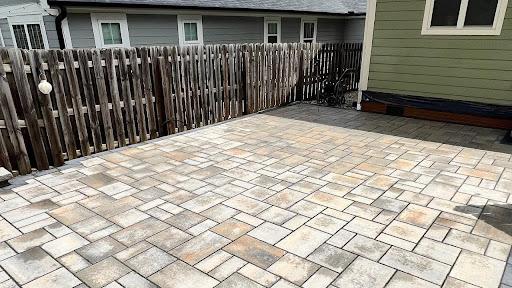Blogs

What Is The Difference Between Hardscape And Paving?
The difference between hardscape and paving is that hardscape refers to all the non-living elements of a landscape, such as stone walls, patios, and walkways, while paving specifically refers to the act of laying down surfaces like concrete, bricks, or stones for paths, driveways, or patios. When it comes to designing outdoor spaces, hardscape and paving are two terms that often come up. Although they are closely related, they serve distinct roles in landscape design. Understanding the difference between these terms can help you make informed decisions for your outdoor projects.
At Greystone Hardscapes, we specialize in both hardscape and paving, turning your outdoor living dreams into reality with unparalleled craftsmanship and quality.
Key Takeaways
Scope: Hardscape encompasses all non-living elements of landscape design, while paving is specifically about creating surfaces for movement.
Materials: Hardscaping includes a variety of materials like stone, wood, and concrete; paving typically involves hard, flat materials such as concrete and asphalt.
Functionality: Hardscape adds structure, aesthetics, and functionality to outdoor spaces. Paving focuses on creating durable, accessible surfaces.
Installation: Paving often requires professional installation for proper leveling and material handling, while some hardscape projects may be suitable for DIY efforts.
Summary: All paving is hardscaping, but not all hardscaping involves paving.
Benefits of Hardscaping in Your Outdoor Design
Hardscaping transforms your outdoor space by adding both functionality and aesthetic appeal. With features like patios, retaining walls, and fire pits, it provides the structural backbone of your outdoor area, enhancing its beauty and usability. Here are key benefits:
Enhanced Property Value: Adds significant curb appeal and value.
Defined Spaces: Creates clear boundaries and functional areas.
Reduced Maintenance: Lowers upkeep needs by minimizing lawn care.
Water Management: Helps manage water flow with grading and retaining walls.
Increased Usability: Provides practical spaces for outdoor activities.
Top Materials for Paving Your Outdoor Space
Selecting the right paving material can drastically impact the look and durability of your outdoor spaces. Here’s a breakdown of popular paving materials and their benefits:
Concrete: Offers strength and versatility; can be customized with colors and textures.
Pavers: Available in various shapes and colors for a customizable look.
Asphalt: Known for its durability and easy repair; cost-effective for driveways.
Natural Stone: Provides a luxurious, high-end aesthetic and durability.
Hardscape Design Tips for Small Yards
Transforming a small yard requires smart design to maximize space and functionality. Consider these tips to enhance your small outdoor area:
Multi-Level Patios: Adds dimension and usability.
Built-In Seating: Saves space and offers comfort.
Vertical Gardens: Maximizes greenery without taking up floor space.
Compact Outdoor Kitchens: Perfect for entertaining in limited areas.
Mixed Materials: Use stone, wood, and pavers to add texture and interest.
How to Choose the Right Hardscape Contractor
Choosing the right contractor is crucial for a successful hardscape project. Follow these guidelines to ensure you select the best professional:
Experience and Portfolio: Look for a contractor with a proven track record and diverse project examples.
Customer Reviews: Check for positive feedback and satisfied clients.
Quality Materials: Ensure they use high-quality materials and follow best practices.
Clear Communication: Opt for a contractor who communicates clearly and provides a detailed contract.
Budget and Schedule: Choose someone who adheres to budget and timeline commitments.
Maintaining Your Hardscape Features
Proper maintenance ensures that your hardscape features remain beautiful and functional. Follow these tips to care for your installations:
Regular Cleaning: Remove debris and dirt to keep surfaces looking fresh.
Sealing: Protect surfaces like stone and concrete from damage and stains.
Prompt Repairs: Address cracks or damage immediately to prevent worsening issues.
Surface Care: For paving, periodic sealing and cleaning will maintain both appearance and safety.
Longevity: Proper care extends the lifespan of your hardscape features.
Frequently Asked Questions About Hardscaping and Paving
1. Which is an example of a hardscape?
Examples of hardscapes include patios, retaining walls, and pathways made from materials like stone, concrete, or brick.
2. What is the difference between pavers and paving?
Pavers are individual units used in paving, while paving refers to the overall process of laying down hard surfaces like driveways and walkways.
3. What is the purpose of hardscape?
Hardscape provides structural features in landscaping, enhancing functionality, defining spaces, and adding aesthetic appeal.
4. What is paving used for?
Paving is used to create durable, flat surfaces for areas such as driveways, walkways, and patios.
5. Is concrete a hardscape?
Yes, concrete is a type of hardscape material used for creating various outdoor structures like driveways, patios, and walkways.
Transform Your Outdoor Space with Greystone Hardscapes
Hardscape and paving are essential elements of outdoor design that can significantly enhance the functionality, aesthetics, and value of your property. Whether you’re looking to create a stunning patio, a practical driveway, or a beautiful landscape design, understanding the distinctions between these concepts is key to making the right choices.
Contact us today to schedule a consultation and take the first step toward transforming your outdoor space into a stunning oasis. Don't wait—your dream outdoor living space is just a call away!
You Dream It.
We Build It.
Superiror Craftmanship.
Every Time.
Hardscape Services:
Copyright © Greystone Hardscapes Inc. 2025. All Rights Reserved. Privacy Policy. Terms & Conditions. Web Design by Fused Media

